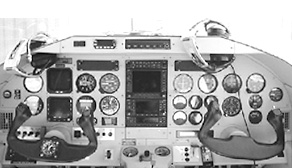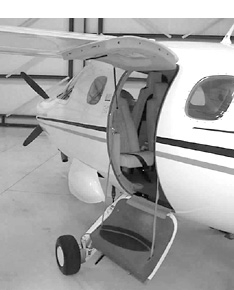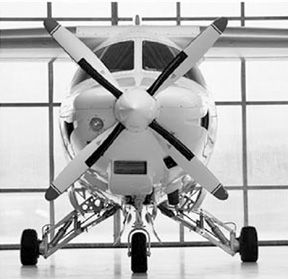Americans have a certain nationalistic myopia when it comes to general aviation airplanes. Proud as we are about being first in powered controllable flight, we forget that the Europeans pioneered flying in hot air balloons in 1783. This fervor spills into our buying habits such that European companies have done poorly in marketing GA airplanes to U.S. buyers.
A notable exception is the aerobatic market, where the highly regarded Extra 200 and 300 from Germany have made inroads in the U.S. With that success behind him, no surprise that Walter Extra would turn his companys attention to building a high-performance cabin-class single.
The result: The six-place, pressurized Extra 400. When it first flew in 1996, it wowed U.S. buyers. But old habits die hard; the airplane still hasnt sold we’ll in the U.S., despite impressive attributes.
The Pedigree
Extra had help with the 400s basic design from the high regarded aeronautical design department at the University of Delft. The wing and fuselage were each optimized for speed rather than low production cost. Extra finalized the design and then faired the wing and fuselage together. The result is an airplane that looks, well, different. From directly in front, its a Learjet with a prop, a high wing and Danish modern landing gear. From some angles, its downright ugly, in our view. Yet from others, its undeniably graceful. Above all, the 400 is fast. At a claimed 225-knot cruise speed, it will walk away from a Piper Mirage.
The Extra 400 received certification through the European Joint Airworthiness Regulations, but is technically at FAR Part 23 airplane. Its currently certified in the U.S. for day and night VFR and IFR operations. Known icing certification testing is in process and is expected this year or early next.
Completed aircraft are flight tested in Germany, then the single-piece wing and horizontal stabilizer are removed and the airplane is shipped to the U.S. via container, something Grob has done with its gliders for years. Its said to be more efficient, since there’s no fussing with tankage or waiting for North Atlantic weather windows.
At just over $1 million-including training for a pilot and mechanic-this is an expensive airplane, leading us to wonder if it can sell widely anywhere, let alone in the U.S. Perhaps if the Eclipse jet doesnt materialize at a price below about $2 million, the Extra 400 may shoehorn its way into the market as the next generation pressurized piston single, if this species even survives. In a nutshell, we like the 400s design and handling but its not without its faults, chiefly stingy load carrying, an interior hardly worthy of a $1 million airplane and the lack of aggressive sales and support network.
Water Buffalo
The engine is a liquid-cooled, Teledyne Continental Motors 350 HP TSIOL-550-C. Its an outgrowth of the successful liquid-cooled engine that powered Burt Rutans Voyager, which completed the first non-stop, unrefueled flight around the world in 1986.
Aggressive weight control yielded an engine and coolant system, including radiator, that isn’t much heavier than a conventional air-cooled engine. Liquid cooling delivers a near constant engine temperature in all operations, allowing the pilot to treat the engine like a turbine without worrying about thermal shock.
For the owner based at a rural airport, its nice to know that the coolant is simply Texaco anti-freeze mixed with water in a 60/40 ratio. The cowling has a series of NACA scoops but no openings for air to cool the cylinders so the reduction in cooling drag, even with a radiator, is significant.
The engine is designed so that loss of engine coolant isn’t an emergency. Oil will cool the engine adequately to allow a flight to be continued to a suitable airport for repairs; urgent but not an emergency.
In fact, there’s already been one failure of a TSIOL-550 on an Extra 400 in the U.S. We were told that a rear bearing seized for reasons unknown. The resulting forced landing caused only cosmetic damage, a tribute to the Extras strong airframe.
One thing we don’t like much is the 1200-hour TBO on the four-blade MTB propeller. We were told the issue is being examined and it needs to be addressed. Overhaul cost is $2400.
Wrapped around the powerplant is a wet lay-up composite airframe with aluminum strips imbedded for lightning protection. In keeping with Walter Extras reputation for overbuilding, the 400 has what amounts to a double-keel arrangement that functions as a set of skids for off field landings and adds rigidity to the airframe while retaining appropriate crush zones to absorb impacts.
The sophisticated seats are designed to stroke to absorb energy so that occupants are protected from impact spikes in the 30 to 40 G range. Partially because of the backward approach that FAA and European certification authorities have taken toward composite structures, the airframe must be substantially overbuilt to allow for voids in the material created during the manufacturing process.
This means that composite airplanes lose what would be a weight advantage over aluminum so they arent any lighter than their metal brethren. But they are stronger for equivalent weight.
The wing, swept back seven degrees to enhance visibility from the flight deck, starts with three spars and is built up as one unit, then attached to the fuselage. The three spars shield fuel during a crash so we suspect the rate of post-crash fires in the 400 due to breaching of the wing in otherwise survivable impacts will be low.
The supercritical airfoil has the noticeable curve on the underside, forward of the trailing edge. While it adds to the top-end speed of the airplane, the airfoil, combined with the small wing area, means that large flaps are needed to hold the stall speed to the mandated 61 knots. And the flaps work. The full-flap stall speed at gross is 59 knots, while the flaps-up stall is 78 knots.
All flight controls are cable and bell crank but are smooth and positive, comparable to a push-rod system. The engine is canted for P-factor, something thats further compensated via an airfoil-shaped vertical stabilizer. At high power, it produces enough lift to the left to overcome left turning tendency during takeoff and climb.

Interestingly, the stabs compensation was also just right for the various cruise power settings and altitudes we tried. But in a normal descent, the vertical fin generates too much lift and left rudder is required. We were told that the S-TEC 55X autopilot will have a yaw trim device-not a yaw damper-that senses and adjusts rudder trim. (No damper is needed, by the way; there’s no tail waggle.)
The 28-volt electrical system is powered by two alternators, one producing 100 and the other 80 amps. Heat is provided from two sources, turbo bleed air and an electrical resistance heater in the cabin. There’s also an electrically powered air conditioning unit.
One clever touch is that the pilot can position switches prior to getting out and locking up the airplane such that the line crew can plug in a ground power unit and activate the heat/air conditioning (without getting into the cabin) in anticipation of the next flight.
The landing gear is hydraulically operated and has a tread of only 7-feet, 3 inches compared to more than 20 feet for a Malibu. While it looks narrow for an airplane of this height, we found that the 400 taxis gracefully and seems to handle crosswinds well. The gear retracts forward and is held up by hydraulic pressure, so the emergency extension system is free-fall. If the engine were air-cooled, we would be concerned about shock cooling and would consider the gear operating speed of 140 knots to be too slow. But the throttle can be chopped without fear so you can slow at will.
However, the 120-knot speed limit for approach flaps is slow for an airplane this fast. We like having approach flaps we’ll out on final to get the nose down and to improve chances of seeing the runway; an extra 10 or 20 knots for flaps would be welcome.
Fuel capacity is 120 gallons but the 400 has to lug around an astonishing 78 pounds (13 gallons) of unusable fuel, something that we think is a definite shortcoming in an airplane in which payload is so limited. We were intrigued by the clever use of a spirit level built into the main doorframe so that the pilot can tell when the airplane is level fore and aft to be assured of being able to drain contamination from the wing tanks.
Another creative feature is found on the de-icing boots. Theyre Teflon coated to enhance ice-shedding ability and theyre actually built into recesses in the wing so that the leading edge contour is retained, keeping the airplane as slippery as possible. The cabin door is the standard split clamshell used on most pressurized single-engine airplanes. It feels sturdy and it can be opened with the airplane on its belly and the flaps extended.
Cabin
The 400s cabin is notably larger than that of its direct competitor, the Piper Mirage, with more room in all directions. But Piper still has the advantage in interior furnishings; Extra has something to learn about how to appoint a cabin for U.S. tastes. For an airplane from the land of Mercedes and BMW, youd think youd at least get seats with armrests and a less spartan cabin. We thought the built-in writing table was just awful in the Extra.
This is the first airplane weve run across in which the gross weight was dictated by politics and taxes. In Europe, taxes and fees on an airplane undergo a quantum leap upward if the airplane weighs more than 2000 kilograms at gross.
Thus, the Extra 400s gross weight is 2000 kilograms or 4407 pounds. The airplane we flew had an empty weight of 3375 pounds, or more than 200 pounds heavier than claimed in promotional materials.

Useful load was a mere 1032 pounds. With full fuel (642 pounds), only 390 pounds could be put in the cabin. Trading bodies for fuel wont go far, either. Load six 170-pounders aboard-if you can find them in our overweight society-and you’ll have payload left for two gallons of fuel.
We believe that Extra can and will get the gross weight bumped for the U.S. variants but until they do, this is not a flexible airplane. We recognize that buyers of this class of airplane may rarely carry more than one or two passengers but nonetheless, some will want to.
With full fuel, the airplane has just under five hours of endurance to dry tanks at 75 percent power (21.4 GPH) and about six and a half hours to dry tanks at 65 percent power. At 20,000 feet, 75 percent power is claimed to be 225 knots, a bit faster than the Piper Meridian. Allowing for a 30-minute cruise climb to FL200, and three-and-a-half hours at 75 percent, this airplane will make short work of an 800-mile trip but will be sucking fumes beyond that.
Flight Deck
The flight deck is nicely laid out. We found the switch and circuit breaker panels to be convenient and easy to use. We were pleased to see there were no head knocking overhead panels that require reverse bifocals to read.
From the left seat, the sight picture is similar to a Learjet, although there’s more head and leg room for the crew. Interestingly, Extra has noticed that the buyers of the airplane in the U.S. tend to be tall so its developing a tall man package, with more aft travel for a pilots seat thats also lowered slightly and with modified rudder pedals to enhance legroom.
We would have thought that in an airplane of this sophistication that the archaic, space-wasting, knee-bashing, control yoke would have been discarded in favor of a side stick. But no. Worse, the yoke design and its range of travel was poorly thought out, in our view.
Its too large, mounted low on the panel and travels aft horizontally, so when moderate roll is needed, the yoke hits the pilots legs, calling for forethought during crosswind operations. A smaller yoke or side controller would help.
Cockpit visibility is superb, on a par with the best of the high-wing airplanes, the Skymaster or Caravan. The windshield is large and the wing sweep eliminates blind spots at the expense of roasting the pilots in all that sunlight.
Avionics are in keeping with this class of airplane, a Bendix/King dual-tube 1461 EFIS for the pilot, Garmin 430s or 530s and an S-TEC 55X autopilot. Being rate-based, this autopilot doesnt have the degree of sophistication this airplane demands, in our view.
On the ground, the nosewheel steering is comfortable and precise, although the airplane rocks slightly from side to side due to the narrow gear tread. Although the 400 has a decent power-to-weight ratio, the short propeller means it doesnt accelerate rapidly. While the prop keeps flyover noise levels down-a big deal in Europe-we trust Extra will find a better performing Hartzell or McCauley.
Rotation is at 73 knots but the airplane rolls awhile before flying, some 1640 feet on a standard day. We noticed only a slight tendency to over-rotate; because of the t-tail, we expected worse.
The Malibu series has a reputation for savoring the ground on takeoff; the Extra 400 will assume that mantle. Clearing a 50-foot obstacle requires 2820 feet from the starting point at sea level. We would be hesitant to base the airplane at an airport with less than 4000 feet of pavement unless there were no obstacles.
Once in the air, the gear retracts forward and turns 90 degrees so that drag increases during the retraction cycle. After liftoff the airplane feels somewhat like an Aerostar, almost ballistic and reluctant to climb until more speed is obtained.
The supercritical wing has a clean stall speed of 78 knots, so it seems almost, as the demo pilot put it, flying on the flaps, until the speed builds above 85 knots and the flaps can be retracted.
There’s little pitch change with retraction, but the flavor of the airplane changes once the flaps are up and the speed approaches Va of 100 KIAS. As the drag curves minimize and the wing optimizes at Va, the rate of climb rises to just over 1000 FPM. Cruise climb generates 700 to 800 FPM of climb.
Smooth Handling
The controls are pure Walter Extra, with no need for rudder except in the steepest turns. Slow flight is precise and comfortable and stalls are docile. The control forces are nicely harmonized and appropriately solid in cruise but responsive to input; the Extra 400 is pleasant to toss around.
On a hot day (18 degrees C at altitude), we set 34 inches and 2400 RPM at 11,500 feet (75 percent power) and generated 194 KTAS, which exactly matched claimed book speed. Tipping the airplane into a descent yielded an immediate need for left rudder; the only time the tail design wasnt spot on for yaw correction. We learned later that if the pilot makes a substantial power reduction (nearly to idle), and then descends, left rudder isn’t needed.
This apparently has to do with the fact the airplane meets emergency descent requirements from 25,000 feet, so it doesnt require supplemental oxygen. We were told that the emergency descent procedure was to simply close the throttle and let the airplane fly itself down to about 10,000 feet, where power would be brought back as desired.
We found the airplane to be flexible in the terminal environment, where the comparison to a turbine again seemed apt. As speed demands changed rapidly from a controllers request to maintain best forward speed to fitting into a downwind behind trainers and then making a tight continually turning descent to final, the ability to make large power changes without cringing is welcome.
The airplane is stable and comfortable configured for an instrument approach at 100 to 115 KIAS but we noticed that landing gear extension reduced yaw stability because the gear doors stay open. The gear is not as stiff as a Malibus; a smooth touchdown requires a finesse but it can be learned.
Conclusion
At a million bucks a copy, the Extra 400 will have a narrow market. While not as easy to fly as a turbine, the 400 is a serious traveling airplane if coupled with a pilot who gets the necessary initial and recurrent training to operate in weather and at the flight levels.
There’s no question, in our view, that the Extra 400 is the most advanced airplane on the market when it comes to crashworthiness and robustness of systems. On the performance front, not only will it outrun Pipers Mirage, its nicer to fly and has a more comfortable cabin and flight deck, plus an engine that we think has to be an improvement over the Mirages star-crossed Lycoming.
On the downside, the 400s useful load is just too small to be considered impressive. Much of that is due to short-sighted certification requirements for composites and moronic European policies toward general aviation. Removing one or possibly both aft-facing seats would provide a little more useful load, but thats still a compromise.
There’s little doubt the Extra 400 has defined the third-generation of pressurized piston singles; it makes the Malibu seem dated. If Extra can find room for the fuel and drops a turbine into the nose, Pipers Meridian will have stiff competition.





